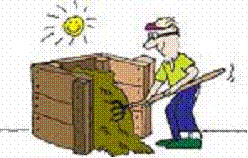




|
The PGSS Environment Committee |
|
Composting |
|
Composting is simply the decomposition of biodegradable organic biomass such as vegetable and plant debris. The end product returns organic matter and nutrients back into the earth, thereby lowering the amount of waste material that goes into landfills. More than 60% of home waste in North America is recyclable or compostable. However, only 8% of waste is composted. Sending the rest to a landfill produces methane, which has 23 times the destructive power of carbon dioxide on the atmosphere.
When adding material to a compost pile, a certain carbon: nitrogen (C: N) ratio must be fulfilled to achieve an optimum decomposition. Carbon is required by decomposing bacteria for energy, while nitrogen contained in protein provides nutrients for building cell structure. High carbon concentrations are found in straw, leaves, sawdust, woodchips, and paper. Materials with relatively high nitrogen content include fresh crop residue such as grass clippings and hay, manure, and discards from fruits and vegetables. |

|
How long it takes for various materials to decompose: · paper in 2 to 5 months · orange peels in 6 months · milk cartons in 5 years · cigarette butts and plastic bags in 10 to 12 years · plastic bottles in 50 to 80 years · disposable diapers in 75 years · tin cans in 100 years · aluminum cans in 200 to 500 years · Styrofoam, NEVER… |
|
How much does the average North American throw away in his or her lifetime? The answer is 600 times his or her weight in garbage. The average will leave 40,909 kg of garbage on the earth that his or her children will live with. Optimal composting is achieved at a C: N ratio of 25-30 to 1. This is because microorganisms use about 30 parts carbon for each unit of nitrogen. For example, mixing equal parts of grass clippings (10-19 to 1) and dry leaves (55-100 to 1) would be ideal. The larger the C: N ratio the longer it will take for the material to breakdown. Coarse materials such as straw, shells, and corn cobs will take longer to breakdown but can be used as bulking agents which allow air circulation when compost piles are compact. If the pile does not heat up, there are not enough materials with a relatively high N content. If the pile smells of ammonia, then it needs more compounds with high carbon content. Table 1 lists some common materials that are high in nitrogen and others that are high in carbon. |
|
Table 1. Everyday materials that are high in either nitrogen or carbon, both of which can be added to compost piles. ----------------------------------------------------------------------------------------------------------------------------------- High nitrogen compounds High carbon compounds Algae Buckwheat hulls Bone meal Cardboard and brown bags Coffee grounds Coffee filters Egg shells Corn cobs and stalks Feathers Cotton/wool/silk scraps Flowers Egg cartons Fruit cores and peels Grass clippings (dried) Nut shells Paper and tissues (Kleenex) Seaweed Peat moss Tea bags Pine needles Vegetable peelings Sawdust and straw Vines Wood chips and wood ash ---------------------------------------------------------------------------------------------------------------------------------------- Sources: (1) “Backyard Magic: The Composting Handbook” Department of the Environment, New Brunswick http://www.gnb.ca/0009/0372/0003/0001-e.asp (2) “Gorilla Composting” http://gorilla.mcgill.ca/ |
|
Some of the materials that should not be put in a compost pile include pet wastes; meat, fish, fat and dairy products; coal ash; cooked food; disposable diapers; glossy magazines; insect-infested or diseased plants; materials treated with synthetic chemicals or herbicides; weeds with mature seeds or plants with a persistent root system such as crabgrass, ground ivy or daylilies; and rhubarb or walnut leaves which contain compounds toxic to insects or other plants. Some of these materials have toxic substances, may attract rodents, and/or can persist in the compost. There are two approaches to composting. The first is the active approach in which oxygen-loving bacteria are allowed to thrive. The compost is constantly mixed to allow its aeration. In the second approach little physical intervention is used. There are several advantages to the first means of composting – material is decomposed faster, less odor and pathogens are produced, and fewer gases that are damaging to the atmosphere are generated. In addition, oxygenated compost produces an organic matter that is rich in nutrients to enable plant growth. The resulting compost also has better water retention, and, when added to regular soil, results in less soil erosion and a longer growing season because dark compost attracts the sun’s heat to warm the surrounding soil. A compost pile should be at least 1 meter in each direction. A pile smaller than these dimensions will not generate enough heat to kill harmful bacteria. A larger pile will compact and keep air out. It is recommended that the compost material be chopped into small pieces, preferably less than 2 inches. This provides more surface area for decomposers to work on. A pile with small pieces of material is better aerated (small pockets of air) and better insulated, and retains more moisture. The material should be added in layers to determine the right amounts of “C” and “N” materials. The material is then thoroughly mixed and the pile is subsequently covered to protect it from rain. If the pile does not subsequently heat up, it may be too small, too dry or needs more “N” materials. The compost pile should be turned regularly when its temperature begins to drop indicating that the food supply for the decomposing bacteria has been utilized. The compost pile should be kept moist as a wrung out sponge. Decomposition is best achieved in the range of 40-70% moisture content. Higher amounts of moisture displace air from the pile, along with leaching nutrients and slowing decomposition. To determine whether there is too much moisture in the pile some composting materials should be hand squeezed. If no drops of water come out there is sufficient moisture in the pile. And if excess water results from squeezing the sample, there is too much water and the pile needs to be turned over. Adding dry substances to the pile will also absorb some of the excess moisture. When the compost pile is composed of brown crumbly material, and turning it does not raise the temperature, then it is ready to be used. A finished compost pile is not usually achieved in less than 120 days. |

|
Indoor Composting |
|
It is possible to compost indoors if you have a basement, garage, or balcony. A large garbage can with a lid is required. Holes are made to allow oxygen to get in. The compost is started with a layer (a few inches) of high C material i.e. shredded leaves, straw, etc… Kitchen scraps are collected into a closed pail which is emptied periodically into the garbage can. More high C materials are added to the discarded pile of kitchen scraps to keep odors down to a minimum. Some topsoil or mature compost is further added. Moisture (enough to keep the components as moist as a wrung-out sponge) is also provided to the developing compost pile to further aid decomposition. |

|
Vermicomposting |
|
Another composting option is to let worms do it. They are put in a perforated container lined with nylon to prevent the smaller ones from escaping. Holes are also put on the bottom of the container for drainage reasons. About a foot of bedding material, such as black topsoil or a mix of shredded leaves, peat, sawdust and soil, is added to the container housing the worms. Water is added to this material (once again to make the components as moist as a wrung-out sponge), along with food scraps to feed the worms. It is suggested that coffee grounds, along with fruit and vegetable peelings (with the exception of garlic and potato), be used in a vermicomposting system. Crushed eggshells prevent the bedding material from becoming too acidic for the worms. Ordinary earthworms are not suitable for vermicomposting. They normally survive on well digested materials. Red wrigglers or fishing bait worms are used because they live on fresh organic compounds. These worms can eat up to twice their own weight on a daily basis and produce castings filled with nutrients. The rule of thumb is to add approximately half a pound of worms (about 500 worms) for each cubic foot of container. For more information on vermicomposting go to http://gorilla.mcgill.ca/compostingathome.htm |
